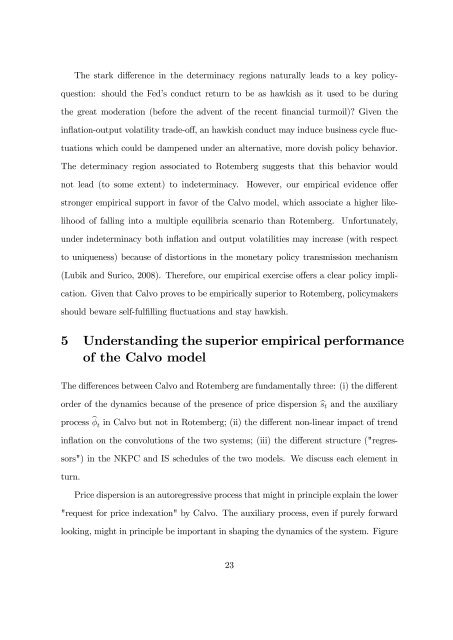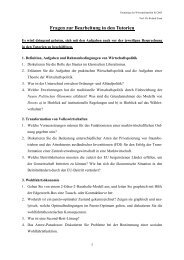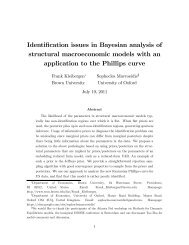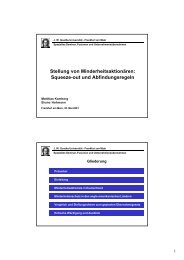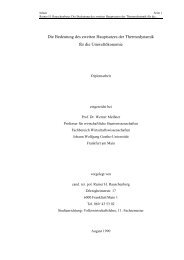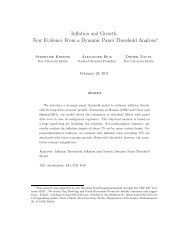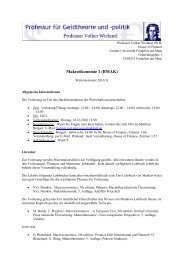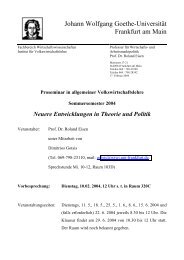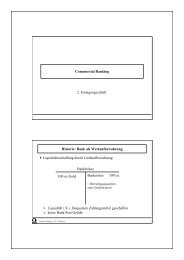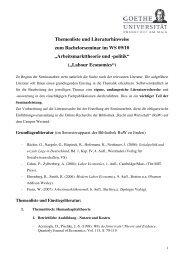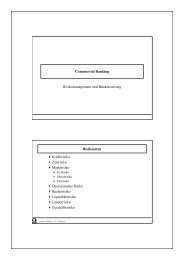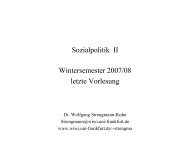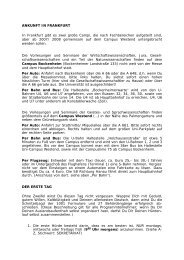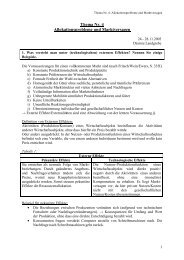Calvo vs. Rotemberg in a Trend Inflation World - Wiwi Uni-Frankfurt
Calvo vs. Rotemberg in a Trend Inflation World - Wiwi Uni-Frankfurt
Calvo vs. Rotemberg in a Trend Inflation World - Wiwi Uni-Frankfurt
You also want an ePaper? Increase the reach of your titles
YUMPU automatically turns print PDFs into web optimized ePapers that Google loves.
The stark di¤erence <strong>in</strong> the determ<strong>in</strong>acy regions naturally leads to a key policy-<br />
question: should the Fed’s conduct return to be as hawkish as it used to be dur<strong>in</strong>g<br />
the great moderation (before the advent of the recent …nancial turmoil)? Given the<br />
<strong>in</strong>‡ation-output volatility trade-o¤, an hawkish conduct may <strong>in</strong>duce bus<strong>in</strong>ess cycle ‡uc-<br />
tuations which could be dampened under an alternative, more dovish policy behavior.<br />
The determ<strong>in</strong>acy region associated to <strong>Rotemberg</strong> suggests that this behavior would<br />
not lead (to some extent) to <strong>in</strong>determ<strong>in</strong>acy. However, our empirical evidence o¤er<br />
stronger empirical support <strong>in</strong> favor of the <strong>Calvo</strong> model, which associate a higher like-<br />
lihood of fall<strong>in</strong>g <strong>in</strong>to a multiple equilibria scenario than <strong>Rotemberg</strong>. Unfortunately,<br />
under <strong>in</strong>determ<strong>in</strong>acy both <strong>in</strong>‡ation and output volatilities may <strong>in</strong>crease (with respect<br />
to uniqueness) because of distortions <strong>in</strong> the monetary policy transmission mechanism<br />
(Lubik and Surico, 2008). Therefore, our empirical exercise o¤ers a clear policy impli-<br />
cation. Given that <strong>Calvo</strong> proves to be empirically superior to <strong>Rotemberg</strong>, policymakers<br />
should beware self-ful…ll<strong>in</strong>g ‡uctuations and stay hawkish.<br />
5 Understand<strong>in</strong>g the superior empirical performance<br />
of the <strong>Calvo</strong> model<br />
The di¤erences between <strong>Calvo</strong> and <strong>Rotemberg</strong> are fundamentally three: (i) the di¤erent<br />
order of the dynamics because of the presence of price dispersion bst and the auxiliary<br />
process b t <strong>in</strong> <strong>Calvo</strong> but not <strong>in</strong> <strong>Rotemberg</strong>; (ii) the di¤erent non-l<strong>in</strong>ear impact of trend<br />
<strong>in</strong>‡ation on the convolutions of the two systems; (iii) the di¤erent structure ("regres-<br />
sors") <strong>in</strong> the NKPC and IS schedules of the two models. We discuss each element <strong>in</strong><br />
turn.<br />
Price dispersion is an autoregressive process that might <strong>in</strong> pr<strong>in</strong>ciple expla<strong>in</strong> the lower<br />
"request for price <strong>in</strong>dexation" by <strong>Calvo</strong>. The auxiliary process, even if purely forward<br />
look<strong>in</strong>g, might <strong>in</strong> pr<strong>in</strong>ciple be important <strong>in</strong> shap<strong>in</strong>g the dynamics of the system. Figure<br />
23


